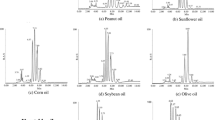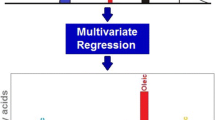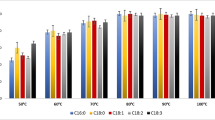Abstract
A novel and easy-to-implement high temperature gas chromatographic procedure for the simultaneous quantitation of free fatty acids (FFA), monoacylglycerols (MAG), diacylglycerols (DAG), and triacylglycerols (TAG) for products arising from fats and oils modification processes has been developed. The method involves silylation in the presence of pyridine at room temperature, standard injection system, and FID detection. Species were separated by carbon number and degree of unsaturation; thus, a total of 53 individual compounds could be quantified. An identification plot for unavailable triacylglycerol standard species relating relative retention time with the number of double bonds was built. Calibration curves for the quantitation of by-products (FFA, MAG, and DAG) and a calibration surface for TAG were constructed using standard solutions. Multiple internal standards were used, achieving good repeatability. The method was tested over a wide range of fatty acid unsaturation level (0 to 3 double bonds) and chain length (C14 to C18). The results achieved in real samples were in agreement with those obtained by fatty acid methyl esters (FAME) analysis and HPLC-RI. The method developed is a rapid and reliable technique to quantify FFA, MAG, DAG, and TAG in substrates and products of modification, ideal to monitor the degree of conversion in fats and oils enzymatic esterification, among others.


Similar content being viewed by others
References
Antoniosi Filho NR, Mendes OL, Lanças FM (1995) Computer prediction of triacylglycerol composition of vegetable oils by HRGC. Chromatographia 40(9/10):557–562
AOCS (2006) Official methods and recommended practices of the American Oil Chemists’ Society. AOCS, Champaign
Aparicio R, Aparicio-Ruiz R (2000) Authentication of vegetable oils by chromatographic techniques. J Chromatogr A 881:93–104
Buchgraber M, Ulberth F, Anklam E (2000) Comparison of HPLC and GLC techniques for the determination of the triglyceride profile of cocoa butter. J Agric Food Chem 48(8):3359–3363
Buchgraber M, Ulberth F, Emons H, Anklam E (2004a) Triacylglycerol profiling by using chromatographic techniques. Eur J Lipid Sci Technol 106:621–648
Buchgraber M, Ulberth F, Anklam E (2004b) Interlaboratory evaluation of injection techniques for triglyceride analysis of cocoa butter by capillary gas chromatography. J Chromatogr A 1036(2):197–203
Carelli AA, Cert A (1993) Comparative study of the determination of triacylglycerol in vegetable oils using chromatographic techniques. J Chromatogr 630:213–222
Christie WW (2005) High-temperature gas chromatography of triacylglycerols. Lipid Technol 17:88–90
da Silva RC, Soares DF, Lourenço MB, Soares FASM, da Silva KG, Gonçalves MIA, Gioielli LA (2010) Structured lipids obtained by chemical interesterification of olive oil and palm stearin. Food Sci Technol LEB 43:752–758
Dijkstra AJ, Christie WW, Knothe G (2007) Analysis. In: Gunstone FD, Harwood JL, Dijkstra AJ (eds) The lipid handbook. CRC, New York, p 415
Fernández-Moya V, Martínez-Force E, Garcés R (2000) Identification of triacylglycerol species from high-saturated sunflower (Helianthus annuus) mutants. J Agric Food Chem 48:764–769
Geeraert E, Sandra P (1987) Capillary GC of triglycerides in fats and oils using a high temperature phenylmethylsilicone stationary phase. Part II. The analysis of chocolate fats. J Am Oil Chem Soc 64(1):100–105
Goñi L, Pacheco C, Constenla DT, Carelli AA (2011) Hidrólisis de lípidos neutros a partir de lecitina cruda de girasol utilizando fosfolipasa A1 como catalizador. XIII Congreso Argentino de Ciencia y Tecnología de Alimentos ISBN 978-987-22165-4-2
Guedes AMM, Ming CC, Ribeiro APB, da Silva RC, Gioielli LA, Gonçalves LAG (2014) Physicochemical properties of interesterified blends of fully hydrogenated crambe abyssinica oil and soybean oil. J Am Oil Chem Soc 91:111–123
Gutiérrez-Ayesta C, Carelli AA, Ferreira ML (2007) Relation between lipase structures and their catalytic ability to hydrolyse triglycerides and phospholipids. Enzym Microb Technol 41(1–2):35–43
Hammond EW (2003) Vegetable oils/composition and analysis. In: Trugo L, Finglas P, Caballero B (eds) Encyclopedia of food sciences and nutrition, 2nd edn. Academic Press, London
Laakso P (2002) Mass spectrometry of triacylglycerols. Eur J Lipid Sci Technol 104:43–49
Lerma-García MJ, Lusardi R, Chiavaro E, Cerretani L, Bendini A, Ramis-Ramos G, Simo-Alfonso EF (2011) Use of triacylglycerol profiles established by high performance liquid chromatography with ultraviolet–visible detection to predict the botanical origin of vegetable oils. J Chromatogr A 1218:7521–7527
López-Hernández A, Torres CF, García HS, Hill CG Jr (2004) Method for analysis of TAG formed by reaction of fish oil with hydrogenated soybean oil. J Am Oil Chem Soc 81(8):743–747
Mangos TJ, Jones KC, Fogtia TA (1999) Normal-phase high performance liquid chromatographic separation and characterization of short- and long-chain triacylglycerols. Chromatographia 49(7/8):363–368
Mozzon M, Pacetti D, Lucci P, Balzano M, Frega NG (2013) Crude palm oil from interspecific hybrid Elaeis oleifera × Elaeis guineensis: fatty acid regiodistribution and molecular species of glycerides. Food Chem 141:245–252
Neff WE, Byrdwell WC (1995) Soybean oil triacylglycerol analysis by reversed-phase high-performance liquid chromatography coupled with atmospheric pressure chemical ionization mass spectrometry. J Am Oil Chem Soc 72(10):1185–1191
Pacheco C, Palla C, Crapiste GH, Carrín ME (2012) Optimization of reaction conditions in the enzymatic interesterification of soybean oil and fully hydrogenated soybean oil to produce plastic fats. J Am Oil Chem Soc 90:391–400
Padley FB, Gunstone FD, Harwood JL (1994) In: Gunstone FD, Harwood JL, Padley FB (eds) The lipid handbook, 2nd edn. Chapman & Hall, London
Palla C, Pacheco C, Carrín ME (2012) Production of structured lipids by acidolysis with immobilized Rhizomucor miehei lipases: selection of suitable reaction conditions. J Mol Catal B Enzym 76:106–115
Plank C, Lorbeer E (1995) Simultaneous determination of glycerol, and mono-, di- and triglycerides in vegetable oil methyl esters by capillary gas chromatography. J Chromatogr A 697(1–2):461–468
Poole CF (2003) The essence of chromatography. Elsevier, Amsterdam
Restek (2005/2006) http://www.chromspec.com/pdf/e/rk86.pdf. Accessed: 10/05/2013
Rezanka T, Mares P (1991) Determination of plant triacylglycerols using capillary gas chromatography, high-performance liquid chromatography and mass spectrometry. J Chromatogr A 542:145–159
Rezanka T, Rezanková H (1999) Characterization of fatty acids and triacylglycerols in vegetable oils by gas chromatography and statistical analysis. Anal Chim Acta 398:253–261
Ribeiro APB, Côrrea Basso R, Grimaldi R, Gioielli LA, Guaraldo Gonçalves LA (2009a) Instrumental methods for the evaluation of interesterified fats. Food Anal Methods 2:282–302
Ribeiro APB, Grimaldi R, Gioielli LA, Gonçalves LAG (2009b) Zero trans fats from soybean oil and fully hydrogenated soybean oil: physico-chemical properties and food applications. Food Res Int 42:401–410
Ribeiro APB, Corrêa Basso R, Grimaldi R, Gioielli LA, Oliveira dos Santos A, Pavie Cardoso L, Gonçalves LAG (2009c) Influence of chemical interesterification on thermal behavior, microstructure, polymorphism and crystallization properties of canola oil and fully hydrogenated cottonseed oil blends. Food Res Int 42:1153–1162
Ruiz-Samblás C, Marini F, Cuadros-Rodríguez L, González-Casado A (2012) Quantification of blending of olive oils and edible vegetable oils by triacylglycerol fingerprint gas chromatography and chemometric tools. J Chromatogr B 910:71–77
Silva SRC, Cotting LN, Poltronieri TP, Balca VM, de Almeida DB, Gonçalves LAG, Grimaldi R, Gioielli LA (2009) The effects of enzymatic interesterification on the physical-chemical properties of blends of lard and soybean oil. LWT Food Sci Tech 42:1275–1282
Viera-Alcaide I, Vicario IM, Graciani Constante E, León-Camacho M (2007) Authentication of fattening diet of Iberian pig according to their triacylglycerols profile from subcutaneous fat. Anal Chim Acta 596:319–324
Acknowledgments
This work received financial support from the Consejo Nacional de Investigaciones Científicas y Técnicas (CONICET), the Agencia Nacional de Promoción Científica y Tecnológica (ANPCyT), and the Universidad Nacional del Sur (UNS) of Argentina.
Conflict of Interest
Consuelo Pacheco declares that she has no conflict of interest. Camila Palla declares that she has no conflict of interest. Guillermo H. Crapiste declares that he has no conflict of interest. María E. Carrín declares that she has no conflict of interest. This article does not contain any studies with human or animal subjects.
Author information
Authors and Affiliations
Corresponding author
Rights and permissions
About this article
Cite this article
Pacheco, C., Palla, C., Crapiste, G.H. et al. Simultaneous Quantitation of FFA, MAG, DAG, and TAG in Enzymatically Modified Vegetable Oils and Fats. Food Anal. Methods 7, 2013–2022 (2014). https://doi.org/10.1007/s12161-014-9830-x
Received:
Accepted:
Published:
Issue Date:
DOI: https://doi.org/10.1007/s12161-014-9830-x




